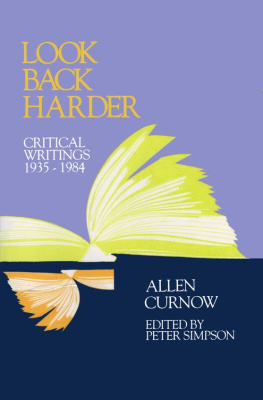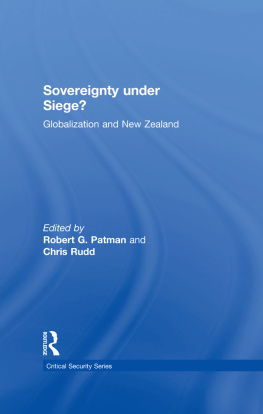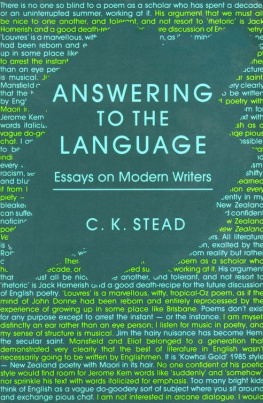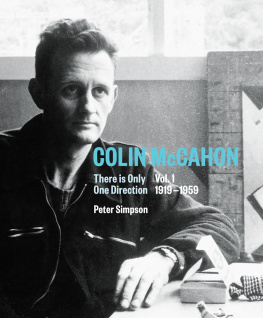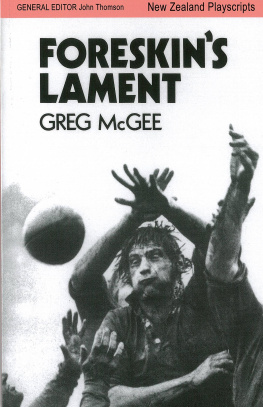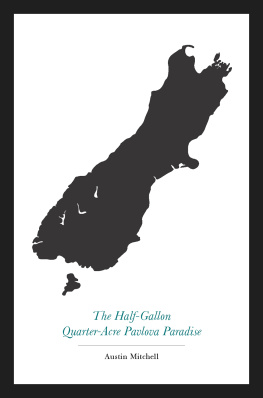T HIS book was Peter Simpsons idea. The plan, the final decisions on the contents, and the title (freely adapted, as he explains, from a poem of mine) are all his. I note that of the pieces first published before 1970, when I first thought of collecting them, nothing has been omitted that I might then have wished to include: on the other hand, among the earliest, a few reappear that I would probably have omitted. Either then or since, it might have seemed a simple enough task for me to complete, had I wished, but in fact it was not. New poems claimed all my attention, and continue to do so; perspectives changed, there was a feeling of being overtaken by literary history, which makes its own choices. Having agreed, very gladly, to Dr Simpsons proposals, I saw myself as his assistant, or consultant, rather than co-editor. I am grateful for all the care he has taken, but specially for his confidence that these collected pieces have something to say, in the sixth of the decades through which they were scattered.
A.C.
My way behind me tattered away in wind,
Before me, was spelt with strange letters.
ROBIN HYDE , WhatisitMakestheStranger?
The rhetorician would deceive his neighbours,
The sentimentalist himself; while art
Is but a vision of reality.
W. B. YEATS , EgoDominusTuus
The centre of reality is wherever one happens to be, and its circumference is whatever ones imagination can make sense of.
NORTHROP FRYE , TheBushGarden
I wanted to place New Zealand at the centre, the only possible place. Never mind the provincial cold-shudder at the thought that this is not the place at all, and never can be; that here is a centre of sorts, but not the centre, wherever that may be.
ALLEN CURNOW , Preface to FourPlays
I
T HE earliest item in this selection of Allen Curnows critical prose was published in 1935, the most recent in 1984 a span of almost fifty years. A rough count by decades indicates that three of the items date from the 1930s, eleven from the 1940s, and five from each of the subsequent decades the 1950s, the 1960s, the 1970s, and the 1980s. It is evident that Curnow has published criticism intermittently at every stage of his long career. His output, though substantial, has not been notably prolific. Unlike, say, his New Zealand contemporaries A. R. D. Fairburn, Frank Sargeson, and James K. Baxter, Curnow has avoided regular broadcasting and reviewing, for instance, as tiresome and distracting,
II
Looking back on four decades of poems in the Authors Note to his CollectedPoems193373, Curnow wrote in 1974: the poetry is all one book. A similar claim could be made about the critical prose of five decades collected here: the criticism is all one book. Despite the length of time over which they were written and the diversity of their character and occasions (manifestos, essays, reviews, introductions, dialogues, prefaces, lectures, interviews, tributes, letters), there is an overall impression of coherence and unity. This effect is intrinsic to the writing; it has not been imposed or contrived by editorial selection. Rather it results from the presence of strong centripetal directions (to borrow from one of Curnows titles) throughout.
The centripetal factors in Curnows criticism involve both subject matter what he chose to write about and approach the how of his criticism, his theory, and method. The centre towards which his writings are directed may be imaged as the site common to a number of intersecting or overlapping circles (as in, say, a quatrefoil), each of which signifies a separate factor, namely genre, national origin (place), historical period (time), and approach. This site constitutes what Curnow in another context called a circumscribed area (p. 201) within his criticism. More than half the items in this selection fall within an area circumscribed by genre (poetry and poetics), place (New Zealand), and time (the modern period). The centre of Curnows criticism, in other words, is undoubtedly modern New Zealand poetry and poetics, viewed from an evolving but consistent perspective.
This is not to say that in his criticism Curnow has never varied his approach or moved outside this circumscribed area, but he has always kept, as it were, one foot inside the inner circle defined by these factors. Thus, when he moves beyond New Zealand in terms of subject matter (as when writing about the prophetic element in modern English poetry, or modern Australian poetry, or Louis MacNeice, or Dylan Thomas, or the poetics of Charles Olson), he restricts himself to writing about poets, poetry, or poetics of the modern period a movement in place but not in time or genre.
Similarly, when Curnow moves beyond the modern period (as in parts of his anthology introductions of 1945 and 1960), it is to consider the nineteenth-century origins of New Zealand poetry a movement in time but not in place or genre. He has never published criticism about pre-modern literature outside the New Zealand context, though his knowledge (and range of reference) is obviously wider than his subject matter. His critical subjects have mostly been drawn from (broadly defined) his own contemporaries whether New Zealanders or otherwise , as is evident from a list of those about whom he has written specific essays or reviews: Fairburn, Mason, Brasch, Baxter, Holcroft, McCormick, Sargeson, MacNeice, Pearson, Lilburn, Glover, Dylan Thomas (all, except Pearson and Baxter who were somewhat younger, born between 1902 and 1915, Curnows own birthdate being 1911).
Again, whenever in his critical prose Curnow moves beyond poetry and poetics to consider other genres or art forms, it is almost exclusively within the contemporary New Zealand context, as when he writes about painting in Canterbury, Holcrofts prose, McCormicks biography of the painter Frances Hodgkins, plays by himself and Sargeson, Bill Pearsons novel CoalFlat, the composer Douglas Lilburn, or literature and the arts in general (in his dialogue with Ngaio Marsh and the lecture New Zealand Literature). In these instances there is a movement in genre, therefore, but not in place or time.
The deliberate restriction of range in the subject matter of Curnows criticism involves the application in his prose of principles which also inform his poetry and playwriting, and which, in his criticism, he applies to the writings of others:
The art of the novel, the lyric poem, the theatre, occurs from time to time, from place to place, in a concrete relation to somebodys vision of some necessarily more or less circumscribed area of experience. (p. 201)
This conviction, consistently adhered to, itself constitutes a further centripetal direction in the criticism.
A conveniently succinct summary of some fundamentals of Curnows critical thinking deriving from this conviction is provided by the digest of opinions which ended a lecture on New Zealand poetry published in 1970:

